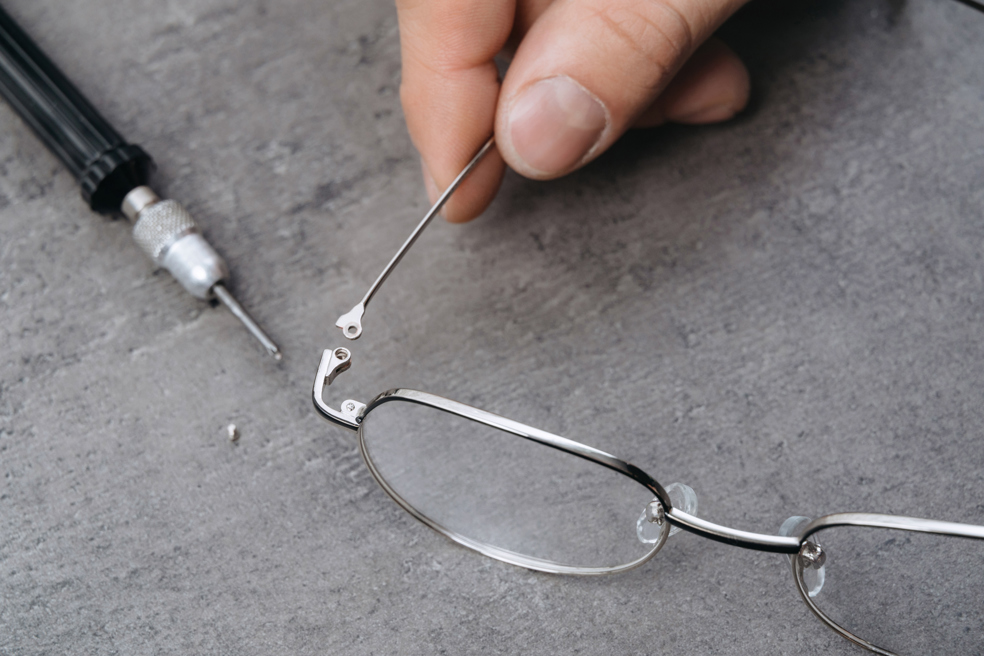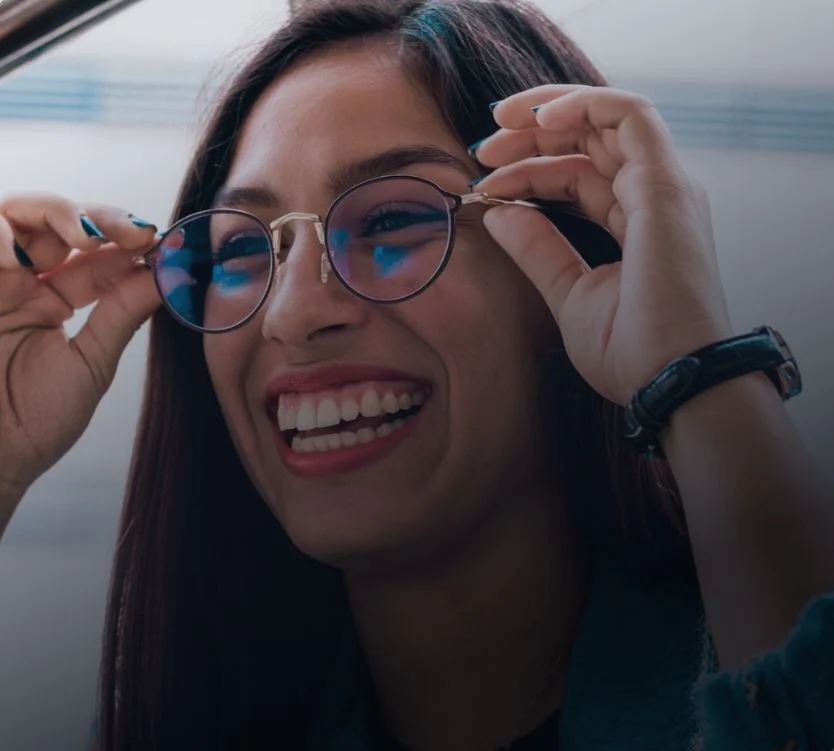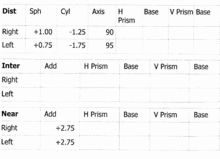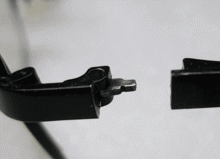Varifocal lenses are a great solution for those who suffer from both long and short-sightedness. Varifocals feature three main sections: the distance zone, the intermediate zone, and the near/reading zone. Each zone caters to a different eye-sight deficiency. With varifocals, you don't need to swap between three different single-vision lenses: varifocals are basically three single lenses in one!
Varifocals are available in a range of different frame sizes, styles, and even weights. Varifocal glasses of the past may have been thick and uncomfortable, but modern lenses are stylish and discreet.
In this guide, we'll explain everything you need to know about varifocals.

Introduction To Varifocals
Getting used to varifocals can take a while, because these lenses have three different layers to them. These layers allow wearers to see clearly at three different distances, with three different focal points built into each layer (this is why varifocal contact lenses are also referred to as multifocal contact lenses).
The upper part of the lens, provides those who are short-sighted with distance vision. The wearer has to look through the top part of the lens in order to see long-distance.
The middle layer is used to see intermediate distances, such as computers, phones, and TVs.
The bottom layer provides near-vision, so it benefits those who suffer from presbyopia (when people struggle to focus on items up-close). There is some degree of soft focus around the edges in both the middle and bottom layers.
Varifocals are often subject to peripheral distortion. This distortion is mostly unavoidable, but should not hamper your vision massively. Modern varifocal designs have managed to shift this distortion to the left and right of the frames, making it barely noticeable.
You may also see and hear varifocal lenses being referred to as progressive lenses, progressive-addition lenses (PALs), or progressive-power lenses (PPLs).
Can Varifocals Be Worn In Small Frames?
Just because you need varifocal glasses does not necessarily mean you need to get big, thick frames. It may be possible to get the varifocal lenses you need in smaller frames.
Exploring varifocal frame size options
As we already discussed in our article: "I do not want big frames with my varifocal lenses", it really depends on how thick you need the lenses, in addition to your routine (i.e. during what activities you'll be wearing varifocals).
Varifocals can generally be made to fit into any size frame these days. Technology has advanced so much since the lens - and several other lens types - was first introduced in the 50s that whether or not varifocals can fit into small frames really comes down to the skills of the optician.
If you book an eye appointment through us, we'll be able to link you up with the best opticians who will be able to provide you with a range of glasses frame options.
Small frames for varifocals
Pros:
-
Thinner frames - In order to fit the varifocal lenses into smaller frames, opticians will have to use thin varifocals. This makes the multifocal lenses less noticeable.
-
Generally lighter lenses - Today varifocal lenses can be made with a lightweight design. If lighter is better for you when it comes to glasses, we'd recommend going for small frame varifocals.
-
Comfortable - Being lighter and made using thinner materials, small frame varifocals will likely be more comfortable to wear.
Cons:
-
Expensive - Small frame varifocal lenses take a lot more effort, and expertise to make. For this reason, multifocal lenses designed for small frames tend to be more expensive.
-
Easier to break - If you opt for small-frame varifocal glasses, you'll have to be extra careful not to break them. The frames and thinner lens will be very delicate.
Recommended frame styles
Small and bespoke varifocal frame options include semi-rimless frames, round frames, and square or rectangular frames.
Medium-sized frames for varifocals
Pros:
-
Balanced glasses - With medium-sized varifocal frames, you get to enjoy the benefits of both small and large frames. You have less bulkiness than large frames, and also less peripheral distortion than small frames.
-
Durability - Medium-sized frames matched with medium-sized lenses create a durable pair of glasses.
Cons
-
Expensive - Although they'll be cheaper than small varifocals, the thinner lens type required will be more expensive to make than large varifocal lenses.
Recommended frame styles
Medium-sized varifocal frame style options include Wayfarer, Clubmaster, and Aviator frames.
Large frames for varifocals
Pros:
-
Maximum vision - Although you can get varifocals in small frames now, the size of the frame will hamper your field of vision. With large frame varifocals, you'll be able to see as much as possible.
-
Larger reading viewing distance - Not only will larger varifocals allow you to see much more of what's in front of you, but they will also expand your reading view. This may make reading easier for some.
-
Minimal blur - The scale of big varifocal frames reduces the amount of blurred vision to the side of the varifocal lenses. This means you'll be able to see more clearly peripherally.
Cons:
-
Bulky - Large frames take up more space on your face.
Recommended frame styles
Large varifocal frame styles include browline frames, geometric frames, and oversized frames.

Are Varifocals Heavy?
Just as varifocal lenses are no longer necessarily thick, they're no longer necessarily heavy, either. In fact, you may struggle to feel the difference between a regular lens and a varifocal lens. Again, this all depends on the varifocal frame size of the varifocal lens you opt for, as well as the frame design you choose.
Let's take a closer look the weight-related considerations of varifocal lenses.
Understanding varifocals lens weight
There are a lot of factors that can affect varifocal lens weight. If your lenses are heavy, there's normally a good explanation for it.
Factors affecting varifocal lens weight
If the varifocal frames you end up buying feel heavy, these reasons would be to blame:
-
Lens material - Most varifocal lenses tend to be made from CR39 (Columbia Resin 39), which is a plastic polymer used in the production of most eyewear lenses today. CR39 tends to be heavier and thicker than most high-index plastics. So, given that CR39 is naturally heavy, it really comes down to how much CR39 is used in the lens design. The more CR39, the heavier the lenses.
-
Lens design - The best varifocal lenses will be made using the latest technology and cut as thinly as possible without hampering your vision. How thin your varifocal lenses are depends entirely on what technology your optician has at hand. With less advanced tech, the lens design will likely be thicker and, therefore, heavier.
-
Frame material - The material used in the frames of your varifocal glasses obviously impacts the overall weight of varifocal glasses designs. If you go for metal frames, titanium will feel the most lightweight. Glasses made using stainless steel or nickel alloys will feel much heavier than titanium-built frames, especially when it comes to holding varifocal lenses.
If you opt for plastic glasses frames, they'll either be made of lightweight cellulose acetate or TR-90. Plastic such as propionate will feel slightly heavier on your face.
Lightweight varifocal lens options
If you're looking for lightweight varifocal style options, you'll need to look for opticians that offer cutting-edge lens technologies.
The benefits of lightweight varifocals are that you barely feel them on your face and that they tend to fit into more stylish designs. Given that they're made using the latest technology, lightweight varifocal glasses may also be able to provide you with a sharper field of vision and better short and long-distance clarity.
Disadvantages include the fact that they may be more delicate, given their lightweight structure. Plus, given the technology required to make them, lightweight varifocals will also likely be more expensive.

Addressing concerns about frame weight
Lightweight frame materials
If you're concerned about varifocal lens frame weight, we'd recommend opting for varifocal glasses that are either made out of titanium. If you'd rather have varifocal glasses featuring plastic frames, we'd recommend going for either TR-90 or CR39.
Frame design considerations for comfort
You could also look out for specific varifocal glasses frame designs that'll surely increase comfort levels:
-
Adjustable nose pads - Being able to adjust the nose pad allows you to better fit the glasses to the structure of your face. Not only does this increase comfort, but it ensures that it reduces the pressure on your nose.
-
Temple tips - With comfortable temple tips, your ears won't pain after wearing your varifocal glasses all day. These tips ensure that the sharp end of your glasses' legs doesn't dig into your skin.
-
Spring hinges - With spring hinges, your glasses frames can flex outward. Like adjustable nose pads, this allows for your glasses to better fit the shape of your face.
-
Extended nose bridge - A longer bridge on your glasses allows for the weight of the varifocal lenses to be more evenly distributed across your face. This reduces the risk of you feeling pain from pressure points.
-
Curved arms - Make sure your varifocal glasses come with frames featuring curved arms. These arms wrap around your ears to provide maximum comfort and stability, while also reducing pressure.







